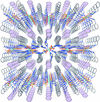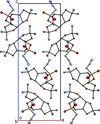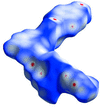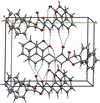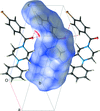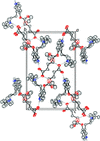issue contents
October 2022 issue

Cover illustration: The principles of crystal packing and space-group symmetry are outlined in a manner conducive to the teaching of basic concepts for a simple planar five-membered heterocycle, 1,3,5-trimethyl-1H-pyrazole, which is constrained to lie on the crystallographic mirror plane of space group Pnma. See: Terwingen & Englert [Acta Cryst. (2022). E78, 966–970].
modern approaches and tools for teaching crystallography
Download citation


Download citation


The title compound represents a textbook example for the arrangement of small molecules and space-group symmetry: in space group Pnma the mirror planes should be occupied to ensure efficient space filling.
CCDC reference: 2203895
research communications
Download citation


Download citation


The solvothermal reaction of H3BO3, sodium tert-butoxide, Rb2CO3 and pyridine led to a new alkaline metal borate hexarubidium hexahydroxydodecaborate dihydrate. Its structure contains a large cyclic dodecaoxoboron cluster, [B12O18(OH)6]6−, formed by six {B3O3} rings. In the crystal, O—H⋯O hydrogen bonds between the components lead to the formation of a three-dimensional supramolecular framework.
CCDC reference: 2192069
Download citation


Download citation


The crystal structure of the title compound comprises polymeric chains formed by two independent copper(II) polyhedra, [CuN2O2] and [CuN4O2], which are linked by sulfate anions and stabilized by extended hydrogen-bonding, C—H⋯π and π–π interactions.
CCDC reference: 2204358
Download citation


Download citation


The packing of isoxaflutole molecules can be rationalized in terms of a hierarchy of interaction energies within columnar and layer arrangements, in each case dominated by the dispersion energy term.
CCDC reference: 2204082
Download citation


Download citation


The synthesis, crystal structure, absolute configuration, spectroscopic and spectrometric details of topiramate azidosulfate, a precursor to the anti-convulsant drug topiramate, are presented.
Download citation


Download citation


The title compound is a non-liquid crystal with a bent-shaped molecule in which adjacent aromatic rings are close to perpendicular to each other.
CCDC reference: 2023150
Download citation


Download citation


The crystal structures of the title compounds consist of discrete octahedral complexes that are arranged in such a way that cavities are formed in which the solvate molecules are located.
Download citation


Download citation


In the crystal of the title compound, molecules are linked by N—H⋯N hydrogen bonds into chains running parallel to the c axis.
CCDC reference: 2165380
Download citation


Download citation


The solvothermal reaction of H3BO3, KCF3SO3, Mg(CF3SO3)2 and pyridine led to a new alkali- and alkaline-earth-metal borate. Its structure features an intricate three-dimensional framework built from [B6O13]8− clusters, thus resulting in a six-connected achiral net with high symmetry.
CCDC reference: 2205808
Download citation


Download citation


The first crystal structure is reported of a molecule containing the 1,4,2-dithiazole-5-thione heterocycle. The packing features aromatic π–π stacking, weak C—H⋯S interactions and short S⋯S interactions.
CCDC reference: 2205416
Download citation


Download citation


The syntheses and low-temperature (90 K) crystal structures of benzyl N′-[(E)-2-hydroxybenzylidene]hydrazinecarboxylate and benzyl N′-[(E)-5-bromo-2-hydroxybenzylidene]hydrazinecarboxylate are presented.
Download citation


Download citation


Eleven (4-phenyl)piperazinium salts containing organic anions have been prepared and structurally characterized.
Download citation


Download citation


The syntheses and low-temperature (90 K) crystal structures of 1-benzoyl-4-(4-nitrophenyl)piperazine and 1-(4-bromobenzoyl)phenylpiperazine are presented.
Download citation


Download citation


The structures of two solvates of the zwitterionic prodrug of the psychedelic 4-HO-DiPT are reported.
Download citation


Download citation


In the title hydrochloride salt, the cation shows an unusually long Si—C bond length. In the crystal, the cations and anions are linked by N—H⋯Cl hydrogen bonds to generate [001] chains.
CCDC reference: 2207007
Download citation


Download citation


The crystal structure of the title gold(I) complex is described. The geometry around the gold atom is nearly linear, and the phosphorus atom of the ligand adopts a slightly distorted tetrahedral geometry. The structure features extensive disorder of the thienyl and phenyl groups with the thienyl substituent disordered over all three possible positions. Molecules of the title compound are held together in the solid state via a variety of intermolecular C—H⋯π interactions.
CCDC reference: 1848959
Download citation


Download citation


Unexpected dual intermolecular hydrogen bonding has been observed in a class of N-aryl-substituted ortho-phenylene diamine compounds. Initially detected in solution by the observation of unexplained signals in the 1H NMR spectrum, it was further corroborated by two-dimensional COSY NMR spectroscopy and solid-state X-ray crystallography data.
CCDC reference: 2207385
Download citation


Download citation


The crystal structure of the trans isomer of monoglycidyl ether of iso-eugenol [GE-isoEu; systematic name 2-({2-methoxy-4-[(E)-1-propen-1-yl]phenoxy}methyl)oxirane] was determined. From a supramolecular point of view, molecules of GE-isoEu are stacked through offset π-stacking interactions involving the aromatic rings.
CCDC reference: 2208338
Download citation


Download citation


The recrystallization of clozapine N-oxide hydrochloride from a range of solvents leads to the loss of half an equivalent of HCl and the formation of single crystals of a hydrogen-bond-linked poly[n]catenane of clozapine N-oxide hemihydrochloride.
CCDC reference: 2208459
Download citation


Download citation


The crystal structure of anhydrous 2,5-dhydroxyterephthalic acid, C8H6O6, was solved and refined using laboratory X-ray powder diffraction data, and optimized using density functional techniques.
Download citation


Download citation


The triclinic structures of dicobalt and dinickel 4,4′-biphenyldicarboxylate dihydroxide, M2(O2CC6H4C6H4CO2)(OH)2 were established using laboratory X-ray powder diffraction data. These structures, as well as that of Mn2(O2CC6H4C6H4CO2)(OH)2, were optimized using density functional techniques. The structure of diammonium 4,4′-biphenyldicarboxylate was also solved using laboratory powder data.
Download citation


Download citation


The title compound, tert-butyl acetylcarbamate, was synthesized by a green method using natural phosphate as a catalyst. The crystal packing shows pairs of molecules forming dimers. These pairs generate centrosymmetric rings with ![[R_{2}^{2}]](/e/issues/2022/10/00/zv2015/teximages/zv2015fi1.svg) (8) motifs linked by a double N—H⋯O=C hydrogen bond. Hirshfeld surface analysis indicates that the major contributions to the crystal packing are from H⋯H (42.6%) and O⋯H (26.7%) contacts.
(8) motifs linked by a double N—H⋯O=C hydrogen bond. Hirshfeld surface analysis indicates that the major contributions to the crystal packing are from H⋯H (42.6%) and O⋯H (26.7%) contacts.
CCDC reference: 2209649
Download citation


Download citation


Three molecules of the title compound are present in the asymmetric unit, exhibiting different conformations relative to the ethoxy group.
CCDC reference: 2174691
Download citation


Download citation


In the title compound, the mononuclear nickel(II) complex exhibits point group symmetry ![[\overline{1}]](/e/issues/2022/10/00/wm5661/teximages/wm5661fi1.svg) .
.
CCDC reference: 2174697


 journal menu
journal menu













